“Bath salts” is the common, collective nickname for a group of artificial, mind-altering drugs sold illegally or illicitly throughout various parts of the United States. All of these drugs contain at least one form of a group of amphetamine-related substances called synthetic cathinones. Doctors and mental health researchers are well aware of the severe health risks associated with bath salt use. According to the results of a new study published in July 2013 in the journal Neuropsychopharmacology, one specific bath salt ingredient—called MDPV—has an addictive power that possibly exceeds the addiction risks of the potent stimulant drug methamphetamine by a considerable degree.
Bath Salt Basics
Bath salts get their name because distributors of the drugs often try to escape law enforcement efforts by labeling their products as bath salts or other seemingly harmless household products. The National Institute on Drug Abuse lists other common euphemisms for these drugs that include phone screen cleaners, jewelry cleaners and plant food. Manufacturers of bath salts also frequently use proprietary names to describe their specific product blends. The federal government outlawed MDPV and a number of other bath salt ingredients in 2012. However, the drugs are still sold through various online and brick-and-mortar outlets. Enforcement of the existing law is complicated by the fact that manufacturers can technically avoid producing illegal forms of bath salts by making certain alterations in the drugs’ chemical formulas.
Basic Addictive Potential
Chemically, bath salts bear a strong resemblance to the stimulants amphetamine and methamphetamine, as well as to the stimulant/psychedelic drug MDMA (better known as Ecstasy). All bath salt products are derived in laboratories from a naturally occurring substance called cathinone, which acts as the main ingredient in the Arabian/African stimulant plant known as khat. Like amphetamine, methamphetamine, and MDMA, the synthetic cathinones in bath salts achieve some of their drug effects by altering normal chemical levels in the part of the brain responsible for producing pleasurable sensations. Use of any substance that strongly affects this brain area comes with significant risks for the development of physical dependence and ongoing addiction. This is true because users of such substances commonly take them repeatedly in an unwise (and ultimately unsuccessful) attempt to consistently, artificially increase their pleasure levels. This attempt can produce addiction by triggering long-term, dependence-supporting changes in normal brain function.
Addictive Power of MDPV
In the study published in Neuropsychopharmacology, a team of researchers from the Scripps Research Institute used laboratory testing of rats to examine the addictive power of MDPV, which is one of the most well-known and widely available bath salt ingredients. This examination followed up on five previous studies conducted by the same team since 2011. During the latest study, the researchers gave a group of rats access to self-administered doses of MDPV and self-administered doses of methamphetamine. The rats gained this access by pressing a control lever a certain number of times; in turn, the number of lever presses required to receive either MDPV or methamphetamine was controlled by the team conducting the experiment. The researchers estimated the addictive potential of MDPV and methamphetamine by counting the number of times the rats would continue to press a control lever without receiving the drug access they sought. When seeking access to methamphetamine, rats in the study previously exposed to the drug were willing to press a lever an average of 60 times before giving up and stopping their acquisition efforts. By comparison, when rats previously exposed to MDPV sought out doses of that drug, they were willing to press a lever an average of fully 600 times before abandoning their efforts. In some cases, specific rats continued to seek out MDPV doses even when their first 3,000 lever presses failed to yield the desired result. As a result of these findings, the authors of the study concluded that MDPV might easily be 10 times as addictive as methamphetamine.
Considerations
Limited real-world observations of people who use MDPV seem to support the findings of the study published in Neuropsychopharmacology. For this reason, the study’s authors are currently undertaking new research designed to assess the effects of long-term use of the drug in human beings. The authors are also looking for ways to predict and/or assess the dangers associated with use of new synthetic cathinone-containing substances produced by bath salt manufacturers. Specifically, they want to devise a way to determine these substances’ addictive power and potential to produce a short-term overdose or longer-term toxic side effects.

